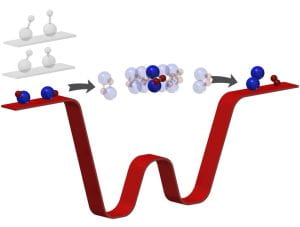
We are building an experiment to explore isotope exchange reactions of Lithium in the ultracold regime, including triatomic reactions such as
6Li7Li + 7Li → 6Li + 7Li2,
and tetratomic reactions such as
6Li7Li + 6Li7Li → 6Li2 + 7Li2.
This system combines theoretical tractability (Li is one of the lightest elements) with experimental control (laser cooling and quantum control of Li is highly mature). On this new platform, we will explore many fascinating topics in the field of chemical reaction dynamics. Several examples are given below.
Gallery



Coherent control of bi-molecular reactivity
Individual reaction events are, in principle, quantum coherent processes. Can we influence the formation products in various allowed exit channels by controlling the quantum states of the reactants?
Theory collabrators: Timur Tscherbul (University of Nevada, Reno); Paul Brumer (University of Toronto); Adrien Devolder (University of Toronto)
Transition between statistical and non-statistical dynamics
What causes the same chemical reaction to take a simple trajectory (non-statistical) across the potential energy surface (PES) in some cases but a complex one (statistical) in others?
Theory collabrators: Bala Naduvalath (UNLV); Brian Kendrick (LANL)
Entanglement between reaction products
The products of a chemical reaction exist, in principle, in an entangled superposition of allowed states. Can we detect and harness this entanglement?
Assembly of ultracold clusters
The coherent assembly of pairs of ultracold atoms into diatomic molecules revolutionized the field. Can we apply the same principles to assemble larger clusters (e.g., triatomic, tetratomic, etc.) as to achieve full internal state control for increasingly large quantum objects?